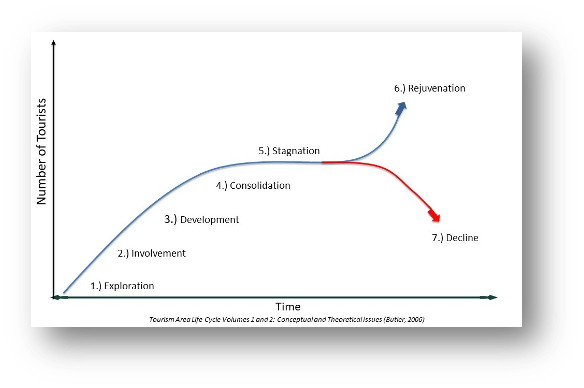Life-cycle models can help tourism destinations chart a path to sustainability
Can a life-cycle model help a destination understand tourism development and plan its future? The answer is: yes.
Michigan State University Extension tourism educators began introducing the Tourism Area Life Cycle (TALC) model, also known as the Butler model, (see diagram) via the First Impressions Tourism assessment program as a way to understand tourism development more clearly. Employing the model as a conceptual way for Michigan communities and destinations to understand stages of tourism growth and the possibilities of decline has proven valuable for some of the state’s more premiere destinations like South Haven. To help chart their future tourism development goals, the Lake Michigan community explored the conceptual cycle via MSU Extension’s Planning for Tourism.
The interactive program leads stakeholders of a community and/or destination through a facilitated process centered on understanding the various TALC stages.
Those include:
- Discovery/Exploration
- Involvement
- Development
- Consolidation
- Stagnation
- Rejuvenation
- Decline
After exploring the intricacies of each stage, facilitation tools and techniques are then employed to capture myriad assets from stakeholders in a team-centered environment. Identified assets are categorized and recognized as having potential to grow a community into an emerging destination or, if necessary, leveraged further to prevent a premiere destination’s decline. Led by MSU Extension tourism educators, Planning for Tourism is ultimately geared toward preventing destination decline, but is only achievable by capturing collective input from an array of businesses, leaders, and residents.
To learn more about Planning for Tourism and other tourism programs, please visit MSU Extension. Planning for Tourism is available to your community/destination either via web or in-person after pandemic restrictions have been lifted. Contact MSU Extension tourism educator Andy Northrop, for more information.
For an in-depth analysis of the TALC model and its applicability to more destinations, I suggest reading, Tourism Area Life Cycle Vol. 1 and 2 (Butler, 2006).



 Print
Print Email
Email